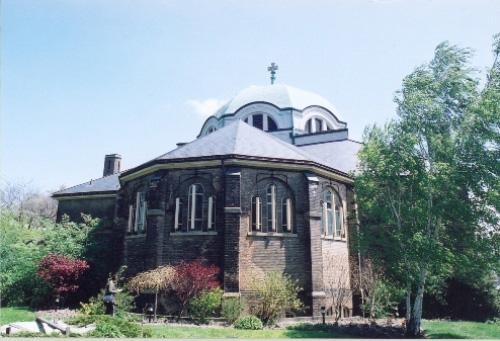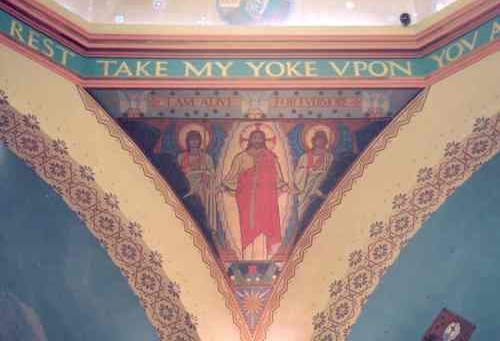St. Anne's Anglican Church National Historic Site

© Ontario Heritage Trust / historicplaces.ca
St. Anne's Church was designated a national historic site in 1997.
Commemorative plaque: in front of church 270 Gladstone Avenue, Toronto, OntarioFootnote 1
St. Anne's Church
St. Anne's vibrant wall paintings make this church a place of national historic significance. They were executed in 1923 by ten Toronto artists, including J.E.H. MacDonald, F. Varley and F. Carmichael from the Group of Seven. Their decorative composition, inspired by Byzantine art, complements the church's architectural style chosen in 1907 by Canon Lawrence Skey, the rector for more than 30 years. The art reflects the revival of nural decoration in the late 19th century, and is also a manifectation of the Arts and Crafts movement which united painting and sculpture with architecture.
Description of historic place
St. Anne’s Anglican Church National Historic Site of Canada is located in a central residential neighbourhood of Toronto, Ontario. Built in 1907-1908 in the Byzantine Revival style, St. Anne’s Anglican Church contains a remarkable cycle of paintings by ten prominent Canadian artists. The elaborate interior mural decorations, designed by J.E.H. MacDonald, cover the walls and ceiling of the apse, the main arches, the pendentives and the central dome. The cycle combines narrative scenes, written texts, as well as decorative plasterwork and detailing accentuating the architectural lines of the building. Official recognition refers to the building and its interior decorative work on its legal lot.

© Ontario Heritage Trust / historicplaces.ca

© Ontario Heritage Trust / historicplaces.ca
Heritage value
St. Anne’s Anglican Church was designated a national historic site of Canada in 1996 because:
- it contains a remarkable cycle of paintings, executed in 1923, by ten prominent artists, including three members of the Group of Seven, under the supervision of J.E.H. MacDonald;
- its cycle of paintings belongs to the revival of mural decoration that emerged in the last quarter of the 19th century and is a manifestation of the Arts and Crafts movement which sought to ally architecture with the sister arts of painting and sculpture;
- the St Anne’s decorative cycle draws upon the motifs, colours and the artistic conventions of Byzantine art, and is integral to the church’s architectural style.
In 1923 J.E.H. MacDonald, having accepted a commission to paint and decorate St. Anne’s, brought in nine more artists including two other members of the Group of Seven, Fred Varley and Frank Carmichael, along with an architect, William Rae, who co-directed the decoration of the interior. In keeping with the design of the building, MacDonald drew on the motifs, colours and artistic conventions of Byzantine artistic traditions, adapting their character to reflect a contemporary Canadian setting.
Lawrence Skey, rector from 1902 to 1933, was the project’s motivating force and was directly involved with the original decision to build in a Byzantine style. This reflected his support for an ecumenical movement that advocated unification with other Protestant denominations. Architect W. Ford Howland’s design was intended to evoke the early Byzantine period, before the Christian church had split into its subsequent numerous denominations. Howland was an associate with Burke and Horwood, a Toronto architectural firm known for their designs of Protestant churches. The art and architecture of St. Anne’s Anglican Church illustrates a distinctive period in Anglican Church history.
Source: Historic Sites and Monuments Board of Canada, Minutes, November 1996.
The National Program of Historical Commemoration relies on the participation of Canadians in the identification of places, events and persons of national historic significance. Any member of the public can nominate a topic for consideration by the Historic Sites and Monuments Board of Canada.
- Date modified :